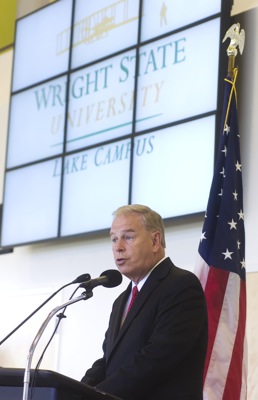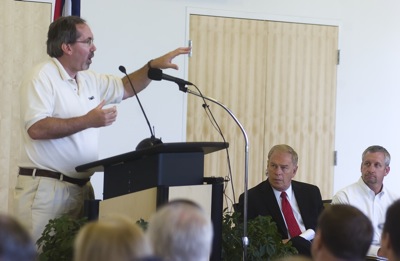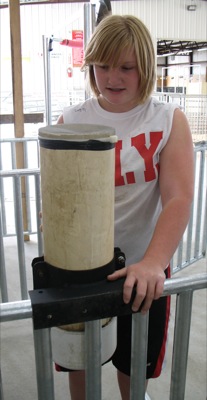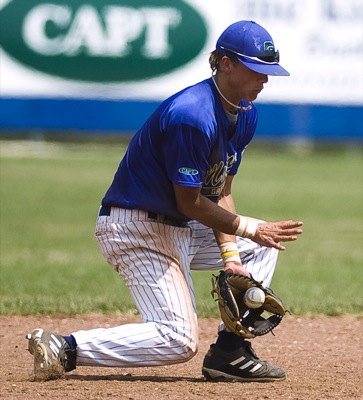Saturday, July 31st, 2010
State plan ready
Officials detail ideas to better water quality
By William Kincaid

Photo by Mark Pummell/The Daily Standard
Ohio Gov. Ted Strickland talks Friday during a news conference about plans to restore Grand Lake. He and other state officials presented ideas to the media and public in the James F. Dicke Hall at Wright State University-Lake Campus in Celina.
GRAND LAKE - Attempts to fix Grand Lake will begin in September.
But there will be no quick fix, said EPA Director Chris Korleski during a press conference Friday at Wright State University-Lake Campus.
Korleski joined Ohio Gov. Ted Strickland and other state officials as they laid out short- and long-term action plans to restore the degraded lake.
Harmful toxins produced by two types of blue-green algae have overtaken the lake and the state has issued an advisory warning people not to go into the water, even in watercraft, and to not eat fish from it.
"We know that our businesses and families have struggled with the loss of activity at the lake this summer. This crisis has been generations in the making, and it will take all of us working together to try to restore this lake to health and prosperity," Strickland said. "This action plan provides a clear direction forward, and I want to thank this community for working with us as we all search for ways to bring this lake back to health."
The action plan focuses on the two issues destroying water quality: the excessive amount of reactive phosphorus already in the water and the continual addition of phosphorus, primarily from farmland, which comprises 80 percent of the 58,000-acre watershed.
The state in September will apply aluminum sulfate (alum) to two areas of Grand Lake in an attempt to neutralize the phosphorous feeding the algae that produces toxins.
"There is no silver bullet; there is no magic wand," Korleski said, adding that although restoration will neither be quick or easy, there is hope.
According to Korleski, the alum will bind the phosphorus. It is then expected to sink - making it unavailable to the algae, also known as cyanobacteria.
The alum will be applied in two demonstration sites 20 to 40 acres large. The locations will be selected next month.
"The recommended projects are designed to test alum's effectiveness on issues directly contributing to Grand Lake's decline, as well as to evaluate potential shortcomings and provide needed data for future decisions regarding a whole-lake alum treatment," according to the state's report used to develop the plan.
If the $250,000 pilot study is effective, the state will pursue a lake-wide application, Korleski said, which could cost $5 to $10 million.
The alum pilot study will be paid through a grant from the Ohio EPA.
"The question is, 'will it work,' " Korleski asked, referring to the alum study. "We don't know. This has been done in other lakes across the world," he said.
But never on a body of water as large as Grand Lake, he added.
Another pilot study called algae flipping would involve adding silica to the lake. It would determine the possibility of replacing the toxic blue-green algae with non-harmful algae called diatoms.
"This would be accomplished by adding a silica material that would theoretically give rise to a population of silica-based diatoms," the state report says. "Theoretically, rather than fostering cyanobacteria blooms, the lake would instead foster the growth and development of non-harmful diatoms."
The $25,000 project will be initiated and funded by the Ohio Department of Agriculture (ODA) if the state determines the process is possible.
Korleski said to his knowledge, algae flipping has never been tested in the U.S. or on a body of water the size of Grand Lake.
Ideally, to fix the lake all 580-million-cubic-yards of the lake sediment should be dredged. But that would cost $100 million and require years of work, as well as land to dump the displaced sediment.
"That's not a feasible option for us to employ," he said.
Some dredging may occur certain discrete areas only, according to the report.
"The Division of Parks and Recreation will strategically focus on dredging activities in and around the mouths of tributaries leading into (the lake)," according to the report.
Korleski also addressed the use of Airy Gators, devices that contain a series of rotating disks that infuse oxygen into the sediment layer on the lake's bottom.
He said Battelle Memorial Institute will review data from the employed Airy Gators to determine further recommendations or actions.
Copies of the eight-page plan were available at the news conference and can be viewed on line at http://www.epa.ohio.gov/portals/47/citizen/GLSMactionplan.pdf.




